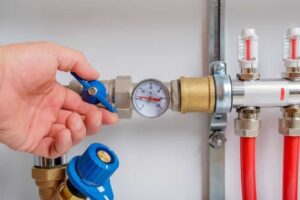Water pressure woes? No power in your shower?
Here’s a decision tree to help you figure out what’s wrong and how to fix it. (These questions assume you’re on a city water system.)
Question 1: Is it the whole house?
Water pressure problems with a single faucet or shower head indicate a problem with that specific piece of plumbing equipment or the pipes leading into it.
It’s just one faucet or showerhead:
If the problem is limited to a specific faucet or showerhead, you could have a clogged pipe or mineral deposit build-up on the faucet or showerhead itself. Buildup is the most common (and easiest to fix).
Here’s a simple solution: Fill a plastic baggie with white vinegar and attach it securely to the showerhead or faucet with a rubber band or twist tie, ensuring that the entire shower head or end of the faucet is submerged. Let it sit for several hours and then remove the plastic bag. Scrub the showerhead or faucet with an old toothbrush to remove even more grime. If the water flow does not improve, it might be a problem with the pipes leading to the faucet or shower. It’s time to call in a professional plumber for advice.
It’s the whole house.
Move on to question 2.

Question 2: Is it just me?
It’s a good idea to check with a close neighbor or two to see if they’re having problems as well.
It’s not just me; nearby neighbors had a sudden pressure drop, too.
If the problem isn’t limited to your house, there’s likely a problem with the city’s
system. They probably already know about it, but it’s a good idea to call them to make a report and request updates.
It’s just me. No one else is having problems.
A sudden drop in water pressure throughout the entire house that’s limited only to your house could be a valve issue. (Assuming, of course, that nothing obvious happened like a leak/flood or visible damage.)
It’s common to have multiple valves controlling water in your home. You may already know about the main shutoff valve. That’s the one you run to if your kid’s homemade rocket ship cracks a pipe and water starts spewing into your basement.
In Minnesota, this main shutoff valve is likely located inside your home due to our variable temperatures. It’s most often near where the city’s pipe enters your home. It should be all the way open. If it was bumped at some point or left partially closed after a repair, it could affect the water pressure in your home.

Question 3: Is it my pipes?
Galvanized pipes are common in homes built before the 1960s and can have rust and sediment trapped inside that can reduce your water pressure. Use a screwdriver to scratch an area on the outside of the pipe- if the scratch looks gray or silver, it’s most likely galvanized or lead pipe.
My pipes are copper, PVC or PEX- no gray or silver color when scratched.
PEX, PVC and copper piping are all signs of healthy, quality piping in your home.
I think my pipes are galvanized pipes or possibly lead pipes.
Galvanized pipes can rust and collect sediment on the inside. This causes the pipes to corrode and contaminate your home’s water supply with lead. When the water line gets restricted by corrosion, galvanized pipes can cause lower water pressure throughout your home. Individual lines (like your shower) can be replaced, or all of your water lines can be upgraded.
Water pressure can tell you a lot about what’s going on in your home. Give Bonfe a call and schedule a plumbing visit today.

